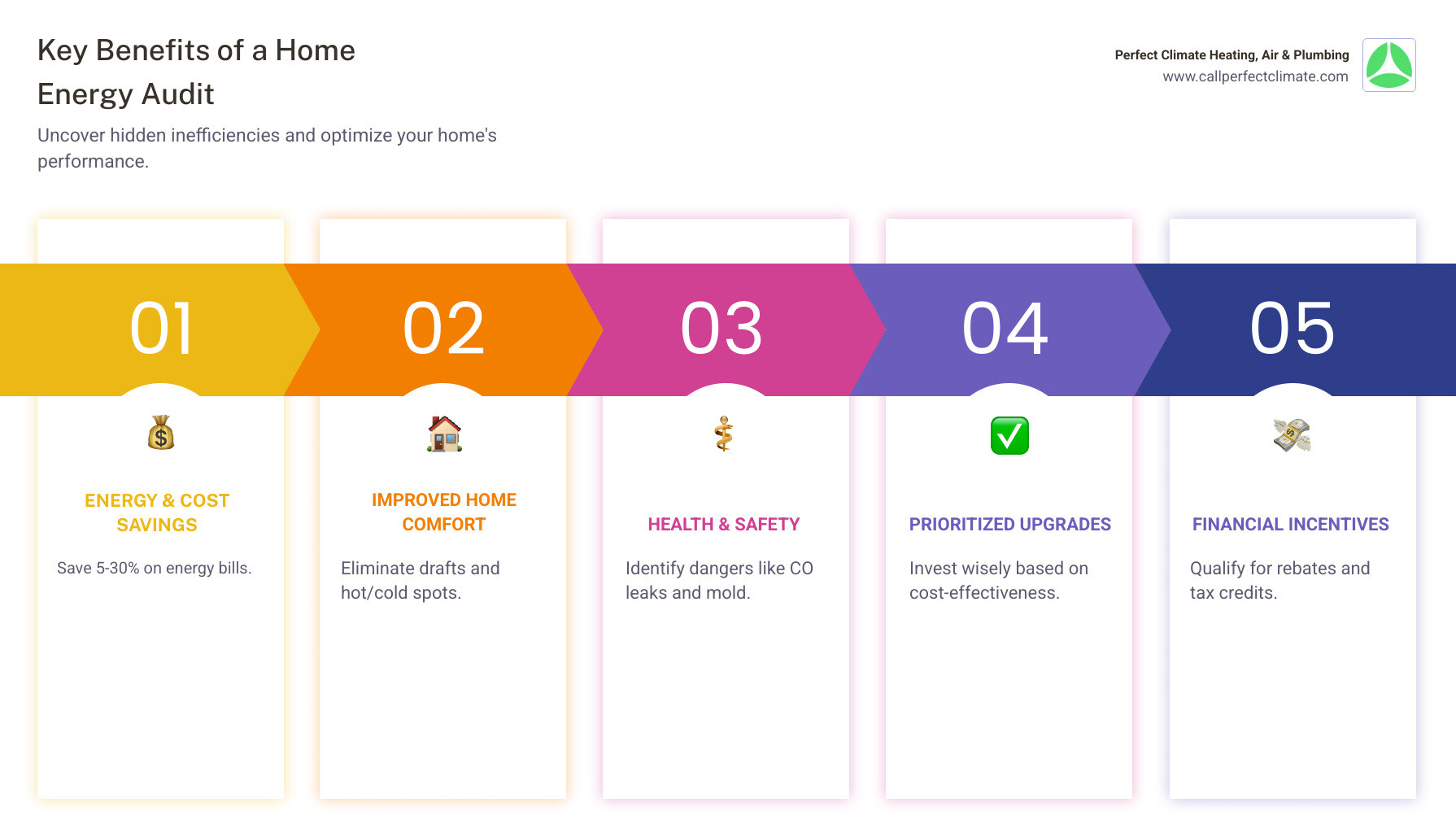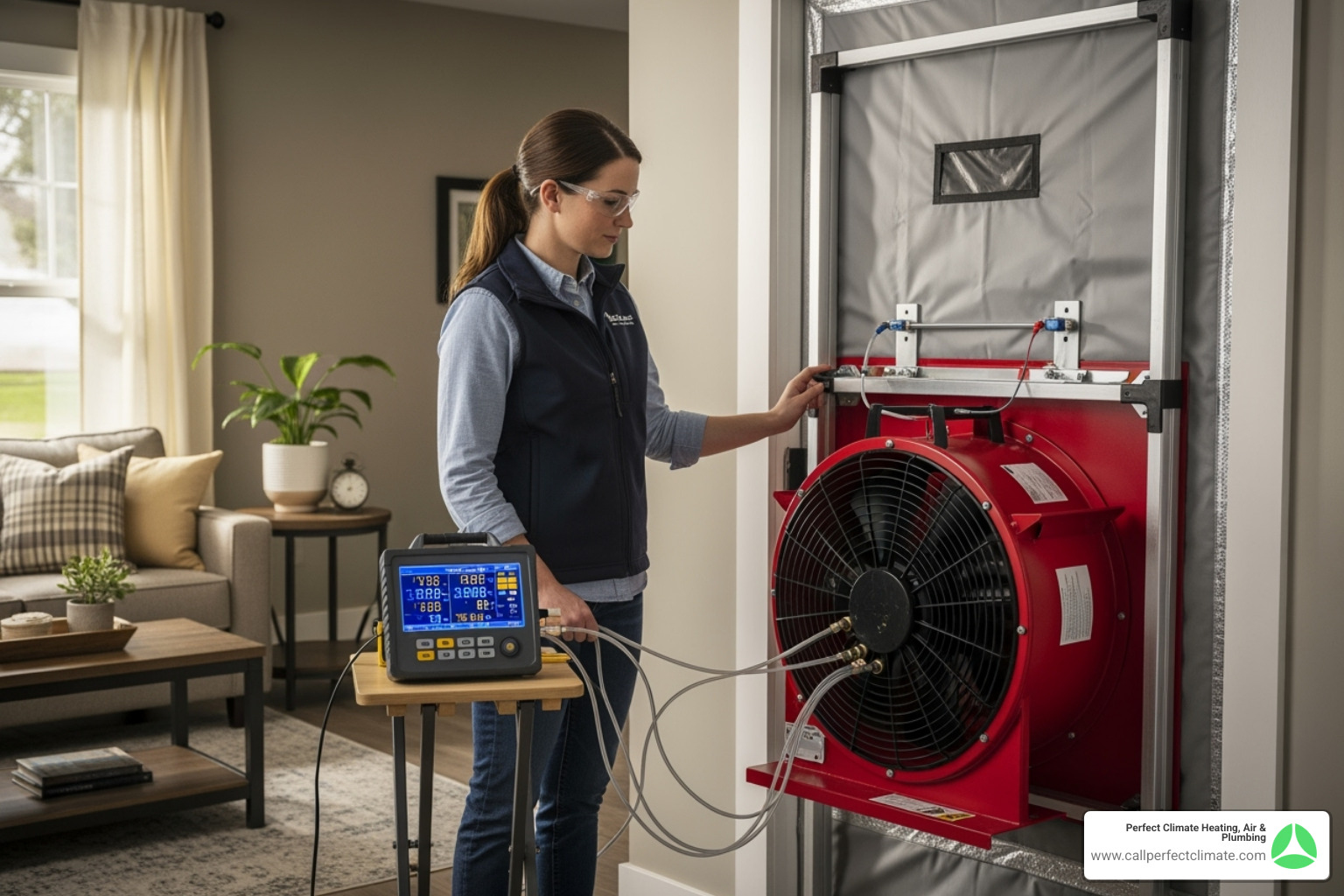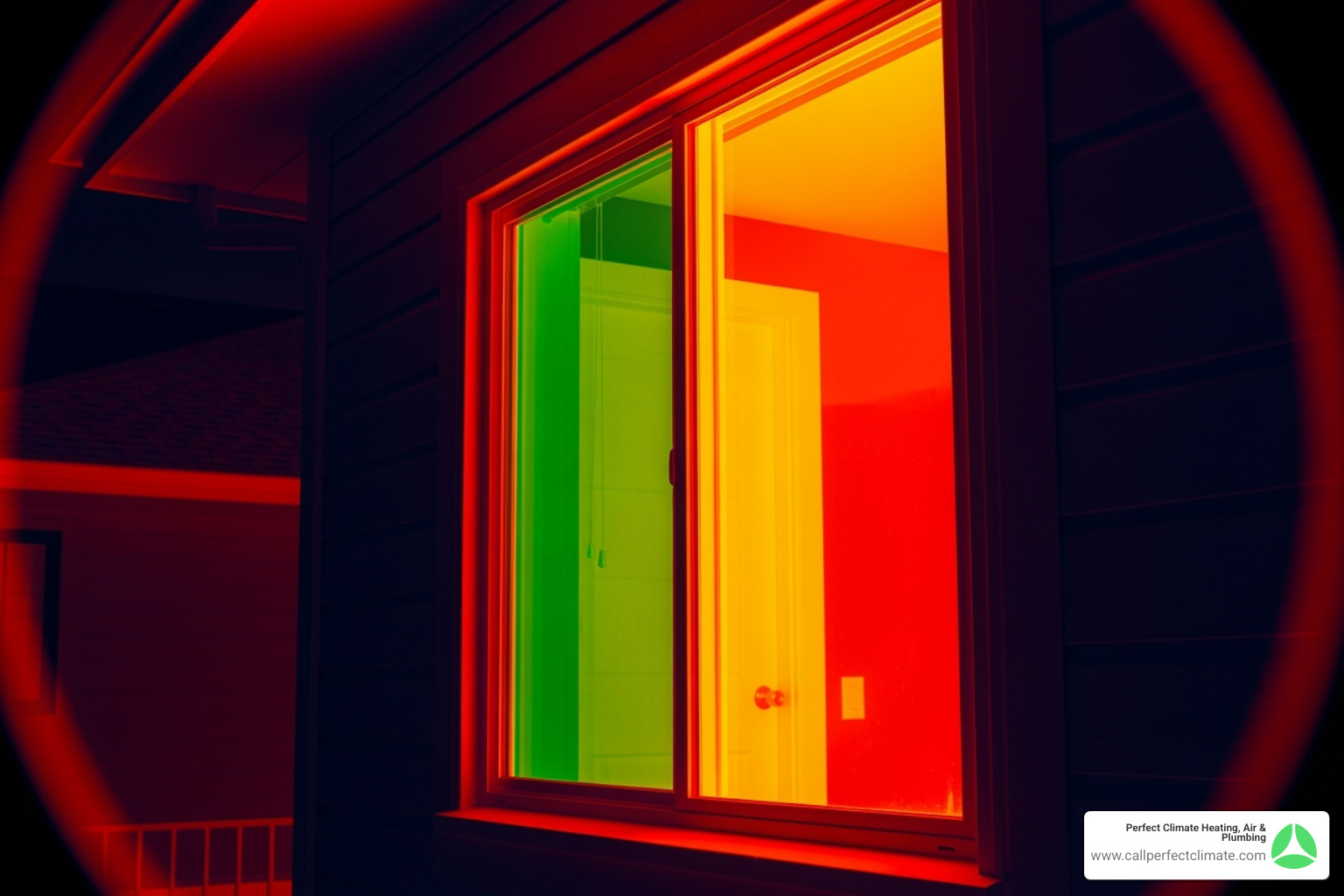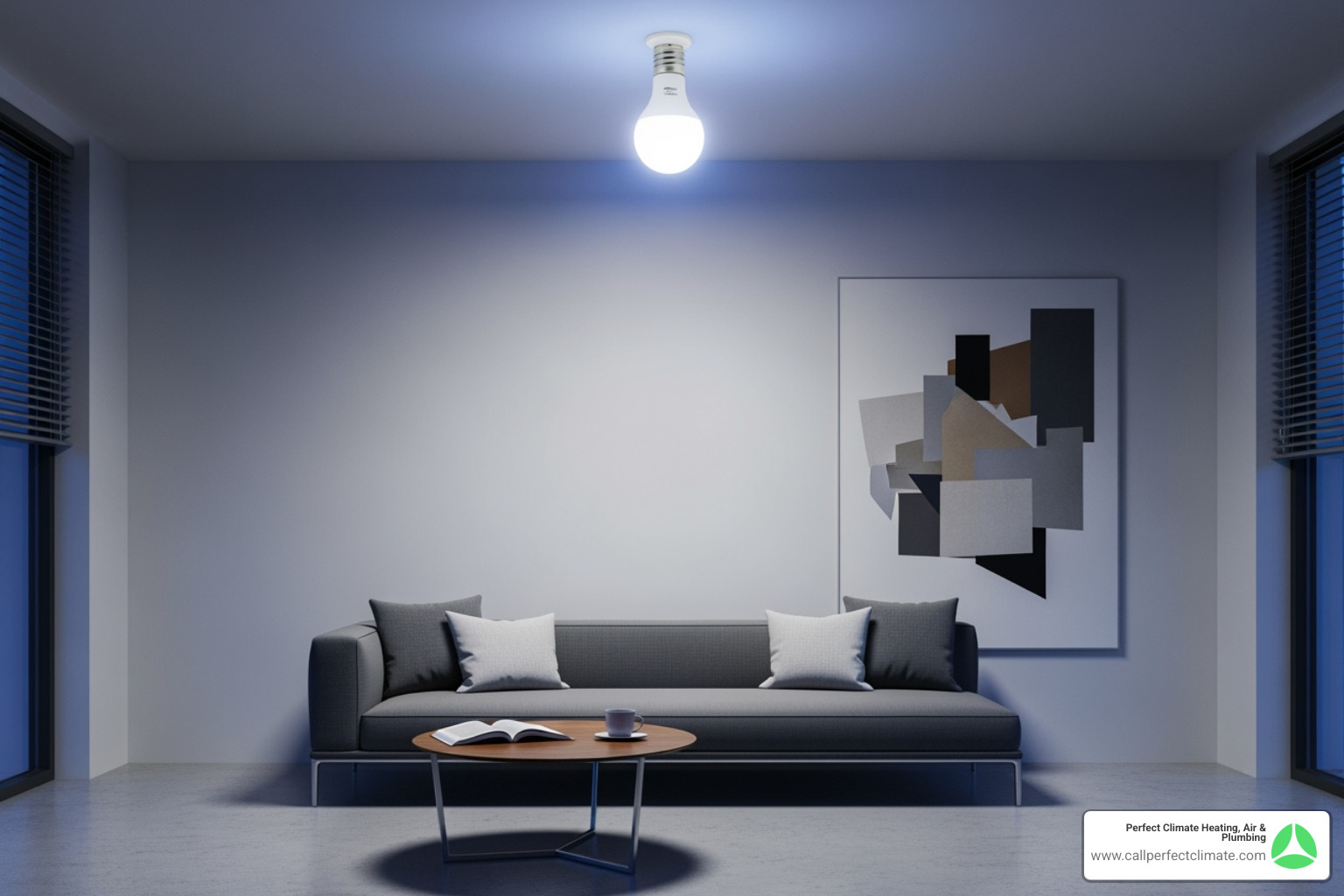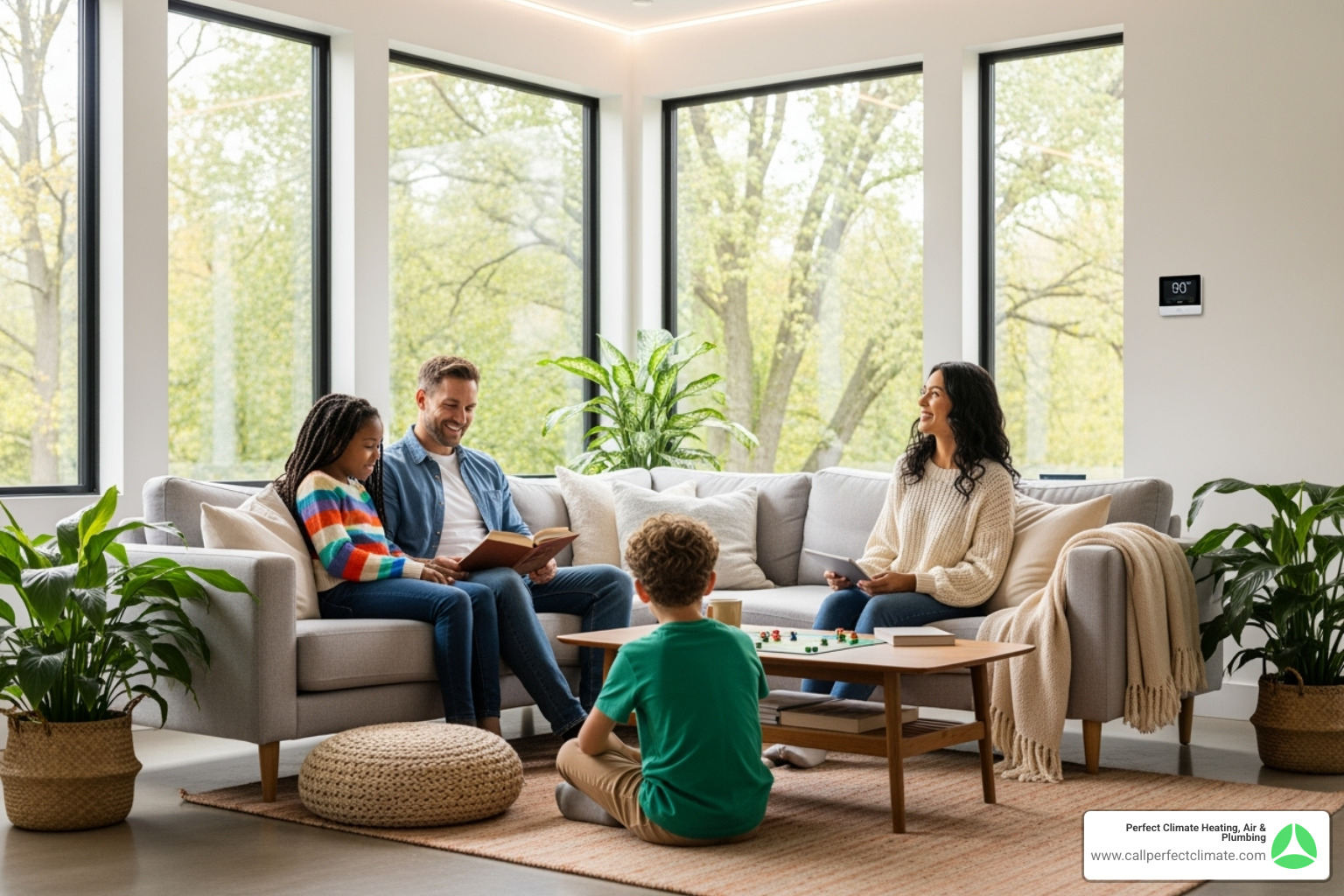Why a Home Energy Audit is Your First Step to Savings and Comfort
A home energy audit is a detailed assessment that identifies where your home is wasting energy and money. Here’s what you need to know:
What is a home energy audit?
- An inspection that shows how your home uses energy and where it’s being wasted
- Identifies the most cost-effective improvements for your specific home
- Can be done as a DIY walkthrough or professional assessment
Key Benefits:
- Save 5-30% on energy bills by acting on audit recommendations
- Improve comfort by eliminating drafts and temperature inconsistencies
- Identify safety issues like carbon monoxide leaks or poor ventilation
- Prioritize upgrades based on your home’s specific needs and budget
Professional vs DIY:
- Professional audits use specialized equipment and provide detailed reports
- DIY audits help find obvious problems and easy fixes
- Both approaches start with the same goal: understanding your home’s energy use
Think of a home energy audit as getting a complete physical for your house. Just like you wouldn’t start taking random medications without knowing what’s wrong, you shouldn’t make expensive energy upgrades without understanding where your home is actually losing energy.
The research shows that acting on audit recommendations can save 5-30 percent on your monthly energy bill. More importantly, an audit helps you avoid wasting money on improvements that won’t make a real difference in your specific home.
Whether you’re dealing with high energy bills, uncomfortable rooms, or planning major upgrades like a new HVAC system, an energy audit gives you the roadmap to make smart decisions about your home’s performance.
Home energy audit terms you need:
A home energy audit, often called a home energy assessment, is our first step to helping you take control of your home’s energy consumption. Its importance lies not just in pinpointing inefficiencies but in giving us a clear, actionable plan to improve your living space. We’re talking about more than just saving money; we’re talking about enhancing your family’s comfort and safety, and preparing your home for a more sustainable future.
The benefits of conducting a home energy audit are profound and extend far beyond just reducing your monthly utility bills. By identifying where your home is inefficient, we can help you make targeted improvements that lead to a more comfortable, healthier, and safer living environment. For instance, by acting on audit recommendations, homeowners can typically save between 5% and 30% on their monthly energy bills. Imagine what you could do with those savings! Beyond the financial aspect, an audit can eliminate frustrating drafts, address uneven temperatures, and improve your home’s overall Indoor Air Quality by identifying and mitigating issues like mold or poor ventilation.
Furthermore, a home energy audit provides a detailed report that helps us prioritize upgrades based on their cost-effectiveness and impact. This means you’ll invest your hard-earned money wisely, focusing on improvements that offer the best return. An audit can also open up financial incentives, as it’s often the first step to qualifying for valuable rebates and tax credits. For example, learning how to ensure your home energy audit qualifies for a tax credit can lead to significant savings on improvements. Lastly, for those considering modernizing their home, an audit is crucial for preparing for electrification, assessing whether your home is ready for upgrades like Heat Pump Systems by evaluating insulation and air tightness.
Professional vs. DIY: Choosing Your Audit Path
When you’re ready to understand your home’s energy use, you have two main paths to choose from. A home energy audit can be either a simple do-it-yourself walkthrough that you tackle on a weekend, or a comprehensive professional assessment using specialized equipment. Both approaches have real value, but they’re quite different in what they can reveal about your home.
Think of it this way: a DIY audit is like doing a self-check for obvious problems, while a professional audit is like getting a full physical from a doctor who has X-ray vision. Many utility companies actually recognize how valuable these assessments are and offer free or heavily subsidized home energy audits to their customers. In some areas, you might even get significant discounts on recommended improvements, making professional audits much more affordable than you’d expect.
Here’s how the two approaches compare:
| Feature | DIY Home Energy Audit | Professional Home Energy Audit |
|---|---|---|
| Depth | Basic visual inspection | Comprehensive analysis with specialized equipment |
| Tools Needed | Flashlight, notepad, maybe an incense stick | Blower door, infrared camera, specialized detectors |
| Findings | Obvious air leaks, visible insulation gaps | Hidden problems, precise energy loss data, safety issues |
| Recommendations | General fixes for visible problems | Prioritized, data-driven roadmap specific to your home |
| Cost | Just your time and small materials | Varies, but often subsidized with excellent ROI |
| Accuracy | Good starting point, but misses hidden issues | Highly accurate with certified professional analysis |
What to Expect from a Professional Home Energy Audit
A professional home energy audit is like hiring a detective to solve your home’s energy mysteries. When you choose this route, you’re getting someone with certified expertise who can see problems that are completely invisible to the naked eye.
Your auditor should be certified by a recognized program – don’t hesitate to ask about their credentials and check references. Before they arrive, gather up your energy bills from the past year and jot down any comfort issues you’ve noticed, like drafty rooms or condensation problems. This gives them valuable context about how your home actually performs day-to-day.
The real magic happens with their specialized equipment. They’ll use a blower door test that temporarily depressurizes your home to measure exactly how leaky it is – think of it as a stress test for your home’s envelope. Even more impressive are the infrared cameras they use for thermographic inspections. These cameras literally “see” heat escaping through your walls, around windows, and through your ceiling. It’s like having X-ray vision for energy waste.
Safety testing is another crucial piece that you simply can’t do yourself. Professional auditors check for gas leaks and ensure your combustion appliances are venting properly. This is especially important if you have a furnace, water heater, or fireplace that burns gas or oil. Improper venting can allow dangerous carbon monoxide to build up in your home – a serious health risk that’s completely invisible.
At the end of the process, you’ll receive a detailed report that’s much more than just a list of problems. It’s a strategic roadmap showing you exactly which improvements will give you the biggest bang for your buck. Many auditors will even provide a U.S. Department of Energy Home Energy Score, giving you a clear rating of your home’s efficiency and a benchmark for improvement.
How to Conduct a Simple DIY Home Energy Audit
If you’re more of a hands-on person or want to start with the basics, a DIY home energy audit is an excellent way to find those easy wins that can make a real difference in your comfort and bills.
Start by creating a simple checklist to keep yourself organized. You can download a helpful one like this sample checklist to make sure you don’t miss any important areas. Having a systematic approach helps you remember what you found and prioritize your fixes.
Finding air leaks is often the most rewarding part of a DIY audit because the results are so immediate. Grab an incense stick or simply use your hand to feel for drafts around windows, doors, electrical outlets, and anywhere pipes or wires enter your home. You might be surprised at how much air is sneaking in and out! The Department of Energy estimates that just sealing these leaks can save you 10% to 20% on your annual energy bills.
Take time to inspect your insulation in the attic and crawlspace if you can access them safely. Look for areas where insulation is thin, uneven, or looks old and compressed. Is it meeting the recommended depth for your climate? Sometimes you’ll find spots where insulation has shifted or settled, leaving gaps that are easy to fill.
Don’t forget to review your past energy bills – this is one of the most revealing steps you can take. Look for patterns in your usage throughout the year and any months where your bills spiked unexpectedly. This detective work often points you toward specific problems worth investigating further.
The Inspection Checklist: Key Areas to Assess in Your Home
A thorough home energy audit, whether you’re doing it yourself or working with our professionals, focuses on several critical areas of your home. Think of it as giving your house a complete physical exam – we’re checking every system to find where energy is sneaking out and money is being wasted.
Sealing the Envelope: Finding and Fixing Air Leaks
Your home’s “envelope” is essentially its protective shell – everything that separates your comfortable indoor space from the outside world. When this envelope has gaps and cracks, it’s like trying to keep water in a bucket with holes. Your heated and cooled air escapes, and outside air sneaks in, forcing your HVAC system to work much harder than it should.
The most common trouble spots are windows and doors, where you can often feel drafts around the frames or even see daylight peeking through gaps. Baseboards and electrical outlets might seem innocent, but they’re notorious for letting air slip through, especially on exterior walls. Don’t forget about plumbing penetrations – anywhere a pipe enters a wall or floor creates a potential pathway for air leaks.
Your fireplace damper deserves special attention. When it’s not sealing properly, it’s essentially like leaving a window wide open. We’ve seen homeowners lose significant amounts of conditioned air up the chimney without realizing it.
The good news is that many of these issues have straightforward fixes. Weatherstripping works wonders for the moving parts of windows and doors, while caulk can seal stationary cracks around frames and trim. For your ductwork, professional Air Duct Cleaning and sealing can address leaks that waste energy by sending conditioned air where it doesn’t belong – like your crawlspace or attic.
The Comfort Blanket: Checking Insulation Levels
Insulation is your home’s winter coat and summer shade all rolled into one. It’s the unsung hero that keeps your living spaces comfortable while preventing your HVAC system from running constantly. When insulation is inadequate or improperly installed, you’ll feel it in both your comfort level and your energy bills.
Your attic is usually the easiest place to assess and often offers the biggest opportunity for improvement. Take a peek up there and look at the depth and evenness of your insulation. If you can see the tops of your floor joists, you likely need more insulation. While you’re up there, make sure your attic vents aren’t blocked – proper ventilation prevents moisture problems that can damage both your insulation and your home’s structure.
Wall insulation is trickier to check without professional equipment, but you can get a sense of what’s there by carefully removing an electrical outlet cover (with the power off!) and gently probing into the wall cavity. If you have a crawlspace or unconditioned basement, check for insulation under your living area’s floor and around perimeter walls.
Understanding R-value – insulation’s resistance to heat flow – helps you determine if you have enough. Higher R-values mean better insulating power, and these ENERGY STAR resources can help you calculate what you have versus what your climate zone needs. Don’t overlook the vapor barrier, which prevents moisture from degrading your insulation and causing structural damage.
The Heart of the Home: Inspecting HVAC and Ductwork
Your heating and cooling system is typically your home’s biggest energy consumer, so keeping it running efficiently is crucial for both comfort and cost savings. During a home energy audit, we pay special attention to how well this system is performing and whether it’s getting the support it needs from your home’s other components.
Regular furnace and AC inspections are essential – we recommend professional maintenance twice yearly to catch small problems before they become expensive repairs. Simple tasks like changing filters every month or two make a surprising difference in system efficiency and indoor air quality, especially if you have pets or during heavy-use seasons.
Duct leaks are energy thieves that often go unnoticed. Look for dirt streaks around duct seams, which signal air escaping or entering where it shouldn’t. Ducts running through unconditioned spaces like attics or crawlspaces need proper insulation to prevent energy loss as conditioned air travels to your living areas.
Proper HVAC Ventilation Requirements ensure both efficiency and safety, particularly for homes with combustion appliances. Our HVAC Maintenance Plans are designed to keep all these systems working together optimally, preventing problems and maximizing efficiency.
Lighting, Appliances, and “Energy Vampires”
Sometimes the biggest energy drains are the ones you don’t think about. Your everyday electronics, lighting, and appliances can quietly consume surprising amounts of power, even when you’re not actively using them.
Switching to LED bulbs is one of the quickest wins in any energy audit. These bulbs last ten times longer than traditional incandescent bulbs and can reduce your lighting energy use by up to 75%. When it’s time to replace major appliances, choosing ENERGY STAR models ensures you’re getting equipment designed for maximum efficiency.
The real sneaky culprits are phantom loads – devices that draw power even when turned off, just by being plugged in. Coffee makers, phone chargers, televisions, and computers are common “energy vampires” that can account for up to 20% of your electric bill. That’s money literally disappearing while you sleep!
Smart power strips automatically cut power to devices when they’re not in use, or you can simply make it a habit to unplug things when you’re done with them. Use a Vampire Calculator to see just how much these silent energy drains might be costing you – the results often surprise homeowners.
Frequently Asked Questions about Home Energy Assessments
When you’re considering a home energy audit, it’s natural to have questions. We’ve helped countless homeowners in our area understand the process, and these are the questions that come up most often.
How long does a professional audit typically take?
A professional home energy audit is thorough, but it won’t take up your entire day. Most audits take 2 to 4 hours, depending on your home’s size and how complex it is. A small ranch home might be done in two hours, while a larger two-story home with multiple systems could take closer to four hours.
During this time, our certified auditor will need access to every area of your home. That means we’ll be checking your attic, basement, and crawlspace – so it’s helpful if you can clear a path to these areas beforehand. We’ll also be moving through every room, testing windows and doors, and using our specialized equipment like blower doors and infrared cameras.
The time investment is absolutely worth it. Those few hours give us the data we need to create a comprehensive report that could save you hundreds or even thousands of dollars over the years.
Is an energy audit necessary for a newer home?
This surprises many homeowners, but yes, absolutely! Even if your home was built just a few years ago, a home energy audit can uncover valuable opportunities for improvement.
Here’s the thing about new construction: building practices and energy-saving technologies are evolving rapidly. What was considered “efficient” five years ago might not meet today’s standards. Plus, construction oversight can sometimes miss details that affect energy performance.
We’ve found issues in newer homes like uninsulated walls that were overlooked during construction, air leaks around newly installed windows, or ductwork that wasn’t properly sealed. These problems can increase your utility bills right from day one, but they’re often hidden and not obvious to homeowners.
An audit on a newer home is also a great way to establish a baseline for your home’s performance. You’ll know exactly how efficient your home is now, which helps you make smart decisions about future upgrades or improvements.
What is the difference between an audit and a Home Energy Score™?
These terms are related but they serve different purposes, and understanding the difference helps you know what to expect.
A home energy audit is the actual hands-on inspection process. It’s when our certified professional comes to your home, uses specialized equipment, and conducts the detailed examination of your home’s energy performance. Think of it as the “investigation” phase.
A Home Energy Score is a standardized report that comes out of that investigation. It rates your home’s energy efficiency on a scale of 1 to 10, similar to how a car gets an MPG rating. A score of 1 means your home uses a lot of energy, while a score of 10 means it’s very energy efficient.
The audit provides the “why” and “how” behind your score. While the Home Energy Score gives you a number and general recommendations, the audit report explains exactly what’s causing energy loss in your home and gives you specific, prioritized recommendations that are custom-custom to your particular situation.
It’s like the difference between getting a report card and understanding what you need to study to improve your grades. Both are valuable, but the audit gives you the detailed roadmap to actually make meaningful improvements.
Take Control of Your Home’s Energy Use
A home energy audit is more than just an inspection—it’s your roadmap to a better home. Think of it as finally getting answers to all those nagging questions about why your energy bills are so high or why that one room is always too hot or too cold.
When you know exactly where your home is losing energy, you can make smart decisions instead of expensive guesses. Maybe you’ve been thinking about replacing your entire HVAC system, but an audit might reveal that simply sealing air leaks and adding attic insulation could solve most of your comfort problems for a fraction of the cost.
The beauty of a home energy audit lies in its ability to prioritize improvements based on your home’s specific needs and your budget. Instead of wondering whether you should upgrade windows or fix your ductwork first, you’ll have a clear plan that tackles the biggest energy wasters first. This targeted approach ensures every dollar you invest works harder for you.
Beyond the money savings, there’s something deeply satisfying about living in a home that just feels right. No more bundling up in blankets during winter or cranking the AC all summer just to stay comfortable. An audit helps eliminate those frustrating drafts, hot and cold spots, and stuffy air that make your house feel less like the cozy retreat it should be.
The health and safety benefits are equally important, though often overlooked. Your audit might uncover hidden dangers like carbon monoxide leaks or poor ventilation that could be putting your family at risk. It’s peace of mind you can’t put a price on.
Once your audit is complete and you have that detailed report in hand, you’re ready to take action. Whether it’s upgrading your HVAC system, improving insulation, or sealing ductwork, the experts at Perfect Climate Heating, Air & Plumbing are here to help you implement those solutions with the professional care your home deserves.
We understand that your home is your sanctuary, and we’re committed to making sure it runs efficiently, comfortably, and safely for years to come. After all, there’s nothing quite like the satisfaction of knowing your home is working with you, not against you.
Ready for a more efficient home? Explore our expert AC installation services

